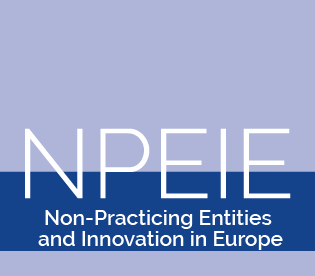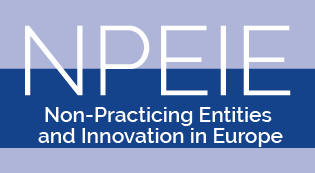ARTICLES
→ Orsatti, G., & Sterzi, V. (2023). Patent assertion entities and follow-on innovation. Evidence frompatent acquisitionsat the USPTO. Industry and Innovation, 1-35.
Patent monetisation is an important source of revenues worldwide. This activity is increasingly carried out by patent assertion entities (PAE), which are at the origin of about 40% of infringement actions filed in the United States. This paper uses an original database of US patents reporting PAE patent acquisitions. We document two key empirical facts about the presence of PAEs in the market for patents. First, PAEs build large patent portfolios and contribute significantly to patent transfers in the US. Second, their impact on follow-on innovation is, on average, negative. With a series of dynamic diff-in-diffs analyses, we estimate a significant post-transfer drop in forward citations received by patentsacquired by PAEs. This drop is not immediate but takes some years to materialise. Heterogeneity tests show that our results are driven by acquisitions of old and highly cited patents, as well as by patent acquisitions by large patent aggregators.
>>> Click here to download
→ Sterzi, V.(2021). Patent Assertion Entities and Patent Ownership Transparency: Strategic Recording of Patent Transactions at the Uspto. Journal of Competition Law and Economics (forthcoming)
Many patent assertion entities (PAEs) hide behind multiple unknown subsidiaries or shell companies with obscure ownership. Meanwhile, the United States Patent and Trademark Office (USPTO), like many other patent offices, does not impose a strict time period for recording the change of ownership of a patent, allowing the holder to gain an advantage by controlling the timing of its ownership disclosure. In this paper, we study to which extent PAEs delay the recording of the U.S. patent reassignments of patents that they will subsequently use in infringement patent lawsuits. On average, PAEs notify the change of ownership more quickly than producing firms, but this is not the case for the patents that they will litigate relatively far in time. In particular, the correlation between the recording lag of the patent transaction and the litigation spell is higher when the patent acquirer is a PAE (than when it is a producing firm) or when the acquirer will litigate the patent in the Eastern District of Texas, famously home to opportunistic litigations. Finally, we find that transactions involving unknown subsidiaries of PAEs are recorded at the USPTO significantly later than those involving PAE parent companies or their known subsidiaries.
>>> Click here to download
→ Sterzi, V., Rameshkoumar, J. P., & Van Der Pol, J. (2021). Non-practicing entities and transparency of patent ownership in Europe: the case of UK dormant companies. Technological Forecasting and Social Change, 172, 121069.
While various studies in the fields of law and economics have analysed the business models of patent aggregators and large non-practicing entities (NPEs) in the US, small NPEs operating in Europe typically escape academic and media attention. Here, to address this imbalance, we specifically identify and characterize the patent portfolios of NPEs registered as dormant companies in the UK and investigate whether they are created for the purpose of acquiring valuable IP assets or launching litigation campaigns. Our econometric analysis – based on more than two hundred NPEs registered as dormant companies in 2019 – supports the second hypothesis. Finally, as an illustrative example of how small NPEs use UK dormant companies to acquire and litigate patents in Europe, we describe the business model of Dragon Green Development Balboa SA, an entity incorporated in the Republic of Panama that controls thirteen UK dormant companies and which is involved in fourteen patent litigation cases in Germany.
>>> Click here to download
→ S. Fusco, F. Lissoni, C. Martinez, V. Sterzi – Monetization Strategies of University Patents through PAEs: an Analysis of US Patent Transfers – ISSI (the International Society for Informetrics and Scientometrics) Proceedings (2019)
The pressure to extract rents from academic research results has led many universities to file more patents and to rely on a growing range of monetization strategies including selling patents to Patent Assertion Entities (PAEs).
We build a database of university patents granted by the USPTO and, for each of them, we collect information about the change of ownership. A first analysis of these data shows that about 12% of university patents have been transferred at least once (including reassignments to universities, hospitals, public research centres and governmental institutions) and only a minor part has been acquired by PAEs (the 0.3% of university patents). However, we also find that most transfers of university patents to PAEs occurred in the last ten years (3.4% of transfers). These acquisitions are largely concentrated in two large PAEs that acquired about 80% of all PAEs-acquired university patents: Intellectual Ventures and Intellectual Discovery.
An econometric analysis on the characteristics of university patents transferred to PAEs shows that patents transferred to PAEs are of high quality, suggesting that PAEs cherry pick good patents for monetization purposes. PAEs acquire also older university patents than those transferred to producing companies. This fact suggests that these transfers are not linked to technology transfer.
>>> Link to the paper
WORKING PAPERS
→ Hervouet, Lorenzon, Righi, and Sterzi (2023). Patent Privateering. Bordeaux Economics Working Paper, 2023-10.
We study operating companies’ delegation of patent enforcement to patent assertion entities, a practice called “patent privateering.” Using a privateer may allow an operating company to generate higher patent revenues, increase rivals’ costs with “stealth” attacks, and limit the legal responsibilities to bear litigation costs. Using data on European patent transfers and patent infringement litigation in five large European jurisdictions in 2010-2020, we show that patent privateering is more likely to occur for patents with relatively lower economic value, for standard essential patents, and when the target of patent assertion is a competitor of the operating company.
>>> Click here to download
→ Sterzi, V., Maronero C., Orsatti G., & Vezzulli A. (2021). Non-Practicing Entities in Europe: an Empirical Analysis of Patent Acquisitions at the European Patent Office
The proliferation of non-practicing entities (NPEs) has become a topic of intense academic debate and an important public policy issue especially in the U.S., where academic researchers have focused most of their attention. On the contrary, conventional wisdom holds that the presence of NPEs in Europe is only marginal, due to some combination of higher cost of enforcement and smaller damages awards. In our study, we criticize this view.
We use a brand-new database of NPE patent applications at the EPO to assess the presence of NPEs in Europe, by reconstructing their patent portfolios and investigating their main patent acquisition sources, together with the industries they operate in. We find that NPEs own almost 20 thousand patent applications filed at the European Patent Office (EPO), mainly in the Electrical Engineering field where they acquire about 9% of all transacted patents in the last decade.
One of our key contributions is to bring data to a heretofore largely theoretical debate about the role of NPEs in the market for technology. We find that, in some respects, NPEs differ significantly from product companies with regard to the characteristics of the patents they acquire, but also that NPEs are very heterogeneous as we find that NPEs’ business models significantly influence the choice of the patents acquired and the use of the patents acquired.
>>> Click here to download
→ Ascione, G. S., Ciucci, L., Detotto, C., & Sterzi, V. (2021). Do universities look like patent trolls? An Empirical Study of University Patent Infringement Litigation in the United States (No. 202105). Centre for North South Economic Research, University of Cagliari and Sassari, Sardinia.
In an attempt to increase revenues from patenting and licensing activities, some universities have started in recent years to pursue “overzealous” strategies to protect their existing patents, by enforcing them in court and selling them to the highest bidder. In our paper, we provide the first comprehensive evidence on the characteristics of universities’ litigation strategies, by comparing patents litigated by
universities to those litigated by patent trolls and other entities. In doing so, we collect data on patent infringement lawsuits in the United States in the years 2003-2016 and we analyze three dimensions that have been identified in the literature as characteristics of patent trolls’ behavior: (i) the intensity with which a patent is litigated, (ii) the choice to file a patent lawsuit in the Federal District Court of Texas Eastern, and (iii) the quality of the asserted patents. We find that while overall universities’ litigation strategies seem to differ from those of patent trolls, this is not the case in the ICT field, the most targeted by trolls, where universities frequently litigate their patents in the Eastern District of Texas and that are of lower quality compared to patents litigated by other entities.
>>> Click here to download
MEDIA AND BROADER AUDIENCE WRITING
→ Martínez, C. and V. Sterzi, published online first 19 March 2020 – Patently misguided, Research Europe
WORK IN PROGRESS
→ Patent privateering (V. Sterzi, A.Hervouet, E.Lorenzon and C.Righi)
Why should operating companies delegate IP monetization to patent assertion entities (PAEs)? In this paper, we study theoretically and empirically the conditions under which patent privateering occurs.
We collect data on patents filed at the European Patent Office (EPO) and eventually litigated infive large European jurisdictions in 2010-2020 and identify patent privateering cases by relying onknown cases as well as on a more general criterion based on the dependence of PAEs on operating companies from which they acquire patents.
We find that patent privateering is more likely to occur (1) for inventions with relatively lower economic value, (2) for Standard Essential Patents (SEPs), and (3) when the sponsor wants to assert the patent against competitors in the same industry.
→ Does the EU market need an ebay-like case? Evidence against granting automatic preliminary injunctions in Europe (V. Sterzi, S.Fusco)
This study examines infringement actions initiated between 2010 and 2019 in five large EU jurisdictions (France, Germany, Italy, Netherlands, United Kingdom) where at least one patent granted by the European Patent Office (EPO) is involved.
In this paper, we look at characteristics of the pairs of firms (plaintiffs and defendants) involved in lawsuits. The analysis reveals that the plaintiffs and defendants operate in different industries in almost 75% of cases, with significant variability across industries and technological fields. The econometric results show that these cases are associated with patents of relatively low economic value, that are old and where settlement is less frequent.
Overall our results suggest that manufacturers need to sustain high costs to thoroughly verify that their innovations are not infringing on any existing patents and that, despite these costs, they may infringe inadvertently.




